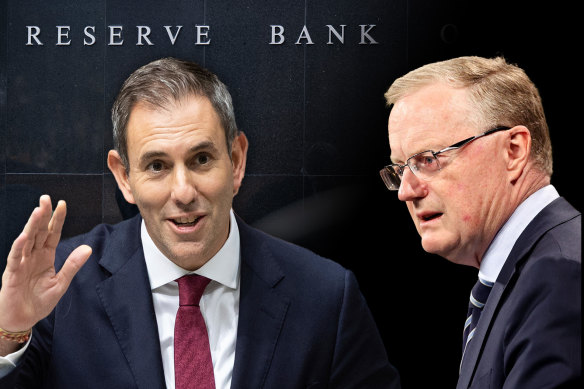RBA governor decision expected this week

Save articles for later
Add articles to your saved list and come back to them any time.
A likely replacement for current Reserve Bank governor Phil Lowe is expected to be announced as soon as this week, as the economy continues to slow off the back of 12 interest rate rises and high inflation.
In a major speech outlining the federal government’s economic wellbeing plans, Treasurer Jim Chalmers acknowledged the pressures from high prices and interest rates were being disproportionately felt by those already struggling and said textbook fiscal policy can only go so far.
RBA Governor Philip Lowe, pictured with federal Treasurer Jim Chalmers.Credit: Sydney Morning Herald
“Responsible economic management and compassion are complementary, not at odds,” Chalmers said his Sambell Oration in Melbourne on Tuesday evening.
“The core of our economic plan is about building healthier, more secure and cohesive communities and a more sustainable and prosperous economy.”
In the coming weeks, the government will release the country’s first national wellbeing framework, containing 50 measurable indicators focusing on areas such as health, environment and work-life balance.
The federal government is also reforming the Reserve Bank following the final report of the Reserve Bank review, which recommended an overhaul of the bank’s governance by the middle of next year.
Chalmers has repeatedly said he would decide this month whether current governor Philip Lowe will remain in the job.
Lowe has faced a barrage of criticism since early 2022 – including recent swipes from the prime minister and treasurer – over his communication and handling of monetary policy.
The governor said as late as November 2021 it was unlikely the bank would raise interest rates until 2024, but within months began an aggressive rate-rising campaign to tackle high inflation.
Lowe, whose seven-year term ends in September, is due to give a speech in Brisbane on Wednesday. It will be his last before he finds out whether his term will be extended or if he is being replaced.
The Greens have been calling for months for the governor to be stood down and the bank’s rate rise decisions to be reversed, while the Coalition’s finance spokeswoman Jane Hume has defended Lowe, saying he should stay on.
The looming decision over who will helm the central bank through the major reforms outlined in the recent RBA review comes as its board also tries to slow the economy without crashing it into a recession.
Chalmers said the government’s economic plan was about improving the budget bottom line and keeping spending down, while also relieving cost of living pressures without adding to them.
The treasurer said the new wellbeing framework has five themes, covering health, security, sustainability, cohesiveness and prosperity. He said if the government wanted to be confident it was making progress, it needed to be measured.
“Of course, we already do that through our traditional economic metrics of GDP, income, and employment. They are important, but they don’t capture the full story,” Chalmers said.
“This will help us to track our journey towards a healthier, more sustainable, cohesive, secure, and prosperous society that gives every person ample opportunity to build lives of meaning and purpose.”
Chalmers said this was the government’s first attempt, and he does not expect everyone to agree they got it right the first time.
“We’re up for the necessary conversations to get it right,” he said.
The next intergenerational report and the employment white paper are also due in the next three months.
In just over a year, the Reserve Bank has lifted interest rates from a record low 0.1 per cent to 4.1 per cent to combat high inflation. The bank board decided to hold off lifting rates at its July meeting so it could assess the impact of its previous rate rises and wait for more economic data.
Data published this week showed the economy was continuing to slow.
Households have been cutting back on spending on non-essentials, while spending on essentials was also continuing to slow according to figures from the Australian Bureau of Statistics.
The 0.6 per cent fall in discretionary spending was driven by a 4.8 per cent fall in spending on household equipment and furnishings and a 3.4 per cent drop in clothing and footwear purchasing, ABS head of business indicators Robert Ewing said.
“While overall household spending rose 3.3 per cent in May compared to the same time last year, it was the lowest growth rate since July 2021. This comes as households respond to cost-of-living pressures,” he said.
The only spending indicator that rose was food, up 5.8 per cent. The May monthly inflation figures show food prices rose by 7.9 per cent.
CommSec economist Ryan Felsman said discretionary retailers were likely to start feeling the pinch as consumers pull back on spending.
“Consumer spending has not yet fallen off a cliff, but volumes are weak and demand is slowing, with households hitting the brakes on discretionary spending and cutting back on essential items,” he said.
“Clothing and fashion retailers alongside furniture and electronics-focused department stores are already reporting a slowdown in shopper demand.”
UBS economists said if the trend of consumer spending does not keep up with inflation – which was 5.6 per cent over the 12 months to May – there was a risk of Australia recording economic growth of just 0.1 per cent in the three months to the end of June.
Separate data from Commonwealth showed household spending intentions were also falling, led by a drop in home buying intentions which dropped 26.2 per cent in June as higher interest rates affect the housing market.
Cut through the noise of federal politics with news, views and expert analysis. Subscribers can sign up to our weekly Inside Politics newsletter here.
Most Viewed in Politics
From our partners
Source: Read Full Article
